
It’s a classic pose, a duck or other waterfowl is swimming along when it upends itself with its head underwater and its tail in the air. What in the world is it doing? Most of us have seen this at some point, as it is a behavior evidenced by one of the most common waterfowl in the northern hemisphere, the mallard, Anas platyrhynchos. It is called dabbling, referring to the definition involving splashing in shallow water (not the one regarding superficial or casual participation in an occupation or hobby).

Dabbling is a feeding behavior. It allows for ducks to reach aquatic vegetation in shallow water without being fully submerged. Species that do this are particularly light and buoyant. They also possess a comb-like structure in their beak called a pecten. This acts as a filter and can strain food out of the water, similar in some ways to the baleen in whales we discussed several weeks ago. It can also be used to preen feathers. While it appears superficially like teeth, the pecten’s composition is also similar to baleen as well as their structure and function (modern birds do not have teeth, as they were lost during the transition from their more reptile-like ancestors like Archaeopteryx).

Not all waterfowl, however, are dabblers. The other main feeding strategy is diving, fully submerging underwater to pursue prey. Some, like the merganser, genus Mergus, and the loon, genus Gavia, are particularly specialized for this behavior. Both of these groups are primarily piscivores (fish eaters), but there are other divers that are bottom feeders instead. For example, the tufted duck below, Athya fuligula, feeds on mollusks, plants, and aquatic insects.. Diving ducks and other waterfowl tend to be heavier and less buoyant. This allows them to better forage for food, but it makes taking to the air more difficult. A diver often needs much more open space to serve as a runway to pick up speed and gain more lift.

Another key difference between dabblers and divers is the placement of the feet. Look again at the picture directly above and then the one of the mallards. Do you see the difference? The dabblers have legs and feet situated in the approximate center of their mass. This allows them to easily walk upright and assists the balancing buoyancy act of the dabbling behavior. The diver, on the other hand, has legs far to the rear. This gives it an excellent propulsion mechanism underwater, but makes walking on land ungainly, or nearly impossible. Not all divers’ legs are situated in such an extreme position (cormorants, an unrelated group of species that also dive for prey, for example), but the farther back the legs are, the more likely that the individual is a diving species and not a dabbling one.
Dabbling and diving are two separate foraging behaviors that allow the coexistence of otherwise similar species by occupying a different ecological niche with regards to diet type and location. The next time you see a duck or similar bird with its butt in the air, take a moment to think about what’s going on underneath the surface of the water. That individual is feeding, in a manner not quite like anything else.
There aren’t many more stories left before the end of Season 5. I hope I’ve introduced you to some interesting diets and behavior patterns that you weren’t aware of before we started this topic. I already have an idea for what I would like to cover for Season 6, but I’m still always interested in hearing about the kinds of stories you all want to read about. Let me know what things you like and please share this with others you think will enjoy it.